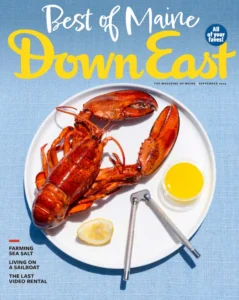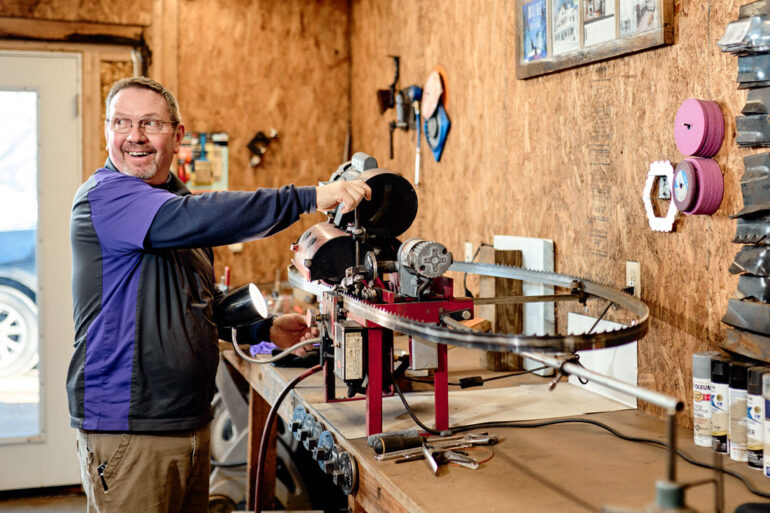By Nora Saks
Photos by Michael D. Wilson
From our April 2024 Home & Garden issue
On a recent afternoon in Complete Sharpening Service (5 Harrison Rd., Bridgton; 207-595-3141), a silver-haired gentleman slid an electric meat-carving knife across the counter. Shouting over the din of a grinder and classic-rock blaring from a radio, he asked owner Gus Fillebrown if he knew how to sharpen it. “Sure thing,” Fillebrown hollered from the back of the workshop, “it’ll be ready in a few days.”
Electric kitchen implements aren’t on the official list of accepted items (ranging from pizza cutters to drill bits to hedge trimmers) Fillebrown displays on a printout in his Bridgton shop, but neither are arrowheads or samurai swords, and he’s honed those. He’ll work on just about anything with a blade, but says that items made from high-quality metals (such as stainless steel, which resists rust and corrosion) are best equipped to withstand repeated sharpenings. The only tools he’s hesitant to tackle are barbers’ shears, because their rounded, razor-sharp edges are particularly tricky to file.
Gus Fillebrown’s sharpening shop used to service saws at the now-shuttered wood-products mills in the Bridgton area. Today, he’s honed in on the needs of homeowners and tradespeople.
Fillebrown took his first stab at blade sharpening in his grandfather’s Norway butcher shop. “I was grinding hamburger meat for him when I was eight years old,” Fillebrown says, “and I’ve got the scars to prove it.” Later, his father gave him an electric whetstone wheel, and though he went on to pursue a career as a carpenter, Fillebrown says, he was always “puttering around, sharpening stuff” for friends, as well as knives for local restaurants. In 2017, the former owner of Complete Sharpening Service, who maintained the saws at the area’s now-defunct wood-products mills for decades, was ready to retire and told Fillebrown he should take over.
Fillebrown spent the first year or so teaching himself the finer points of the trade, like how to manually sharpen saw-blade tips and teeth. Given the mill closures, “I knew I’d be focusing on homeowners and tradespeople,” Fillebrown says. But the pandemic brought an influx of new customers, as homebound Mainers started breaking out their dusty woodworking and gardening tools. Seven years on, business is booming, which Fillebrown admits he finds slightly confounding, given that “most people are more apt to buy something new than fix it.” He says he sharpens thousands of saws and hundreds of lawn-mower blades and kitchen knives per year, and he enjoys showing clients the inherent value in their tools. “You don’t need to throw everything away, especially the older stuff that’s built to last,” Fillebrown says. “Fix what you’ve got, sharpen it, keep using it.”
Knife Pointers
Tips for maintaining your edge.
CLEANING: Wash knives by hand, not in the dishwasher, which can dull the blades and damage the handles. To prevent rust, dry them thoroughly before putting them away.
CUTTING: Slice on wood or plastic surfaces (which have some give), never on glass or metal, which will blunt blades.
SHARPENING: Run blades over a steel or ceramic honing rod before using them or when they feel dull. The rod “doesn’t actually sharpen the edge but maintains it by realigning the tiny teeth,” Fillebrown says. Sharpen knives when honing is no longer effective.







